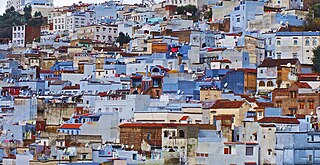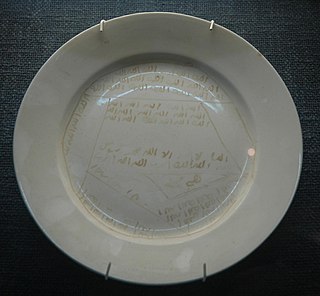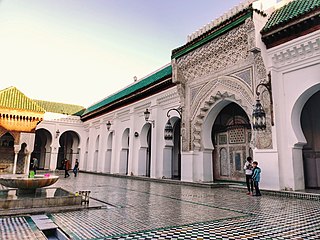
Tripoli is the capital and largest city of Libya, with a population of about 1.1 million people in 2019. It is located in the northwest of Libya on the edge of the desert, on a point of rocky land projecting into the Mediterranean Sea and forming a bay. It includes the port of Tripoli and the country's largest commercial and manufacturing center. It is also the site of the University of Tripoli. The vast Bab al-Azizia barracks, which includes the former family estate of Muammar Gaddafi, is also located in the city. Colonel Gaddafi largely ruled the country from his residence in this barracks.

Benghazi is the second-most populous city in Libya as well as the largest city in Cyrenaica, with an estimated population of 807,250 in 2020. Located on the Gulf of Sidra in the Mediterranean, Benghazi is also a major seaport.

Karaman, historically known as Laranda, is a city in south central Turkey, located in Central Anatolia, north of the Taurus Mountains, about 100 km (62 mi) south of Konya. It is the capital district of the Karaman Province. According to the 2000 census, the population of the province is 231,872 of which 132,064 live in the town of Karaman. The district covers an area of 3,686 km2 (1,423 sq mi), and the town lies at an average elevation of 1,039 m (3,409 ft). The Karaman Museum is one of the major sights.

Moroccan architecture refers to the architecture characteristic of Morocco throughout its history and up to modern times. The country's diverse geography and long history, marked by successive waves of settlers through both migration and military conquest, are all reflected in its architecture. This architectural heritage ranges from ancient Roman and Berber (Amazigh) sites to 20th-century colonial and modern architecture.

Ghadames or Ghadamis is an oasis Berber town in the Nalut District of the Tripolitania region in northwestern Libya.

Malek National Museum and Library is a museum and national library in Tehran, Iran. Malek National Library and Museum Institution (MNLMI) is the first private museum of Iran, and one of the 6 large libraries holding the exquisite manuscripts. The MNLMI collection is a rich trove of the best manuscripts and Iranian historical artworks. The Institution is located in the historical precinct of “Bagh-e Melli”, that is considered the cultural-historical center of Tehran. Usually, the MNLM visitors are numerous university students and researchers, as well as tourists who enjoy its library and museum facilities. It is one of the biggest libraries of precious manuscripts in Iran, built by Hadji Hussein Agha Malek, the richest man in Iran at the time. He built it in a traditional Persian architecture style. One of the biggest contributors is Esat Malek Malek, Hadji Hussein Agha Malek's eldest daughter, who contributed to the museum's development.
Ahmed or AhmedKaramanli or Qaramanli or al-Qaramanli, (1686–1745) was of Janissary origin and a Member from the Karamanids. He founded the Karamanli dynasty (1711–1835) of Tripolitania or Tripoli. He reigned (1711–1745), as the first Karamanli Pasha of Tripolitania.

Yafran, also spelled Jefren, Yefren, Yifran, Yifrin or Ifrane, is a city in northwestern Libya, in the Jabal al Gharbi District in the western Nafusa Mountains. Before 2007, Yafran was the administrative seat of the Yafran District.

Tourism in Libya is an industry heavily hit by the Libyan Civil War. Before the war tourism was developing, with 149,000 tourists visiting Libya in 2004, rising to 180,000 in 2007, although this still only contributed less than 1% of the country's GDP. There were 1,000,000 day visitors in the same year. The country is best known for its ancient Greek and Roman ruins and Sahara desert landscapes.

The Gurgi Mosque is a mosque in Tripoli, Libya. It lies in the heart of old Tripoli as part of a complex of historic buildings. The mosque is an important tourist attraction, as is the area as a whole; nearby is the Roman Arch of Marcus Aurelius.

The Red Castle Museum, also known as As-saraya Al-hamra Museum, the Archaeological Museum of Tripoli or Jamahiriya Museum, is a national museum in Libya. It is located in the historic building known as the Red Castle of Tripoli, sometimes also referred to as Red Saraya, on the promontory above and adjacent to the old-town district with medina Ghadema.

The Martyrs' Square ; known as Green Yard under the Gaddafi government; Independence Square during the monarchy; and originally known as Piazza Italia is a downtown landmark at the bay in the city of Tripoli, Libya. The main commercial center of the city surrounds the square. The Square is also a main tourist attraction in Tripoli. It has a large legendary fountain done by an Italian architect at the centre of the square. The square is the meeting point of many different avenues. Omar Mukhtar Avenue is one of the longest in North Africa, it was built by Italians in the colonial time, and Libyans during the era of King Idris I. Independence Street branches from the square too, and it leads to the Palace of King Idris I. 24 December Avenue is also an Italian built avenue. Mizran Street is the last street that branches from the Martyrs' Square.

The Islamic Museum of Tripoli is a proposed museum of Islamic culture that was built under the support and patronage of Saif al-Islam Gaddafi in Tripoli, Libya.

The Museum of Libya is a museum located in Tripoli, Libya. It was originally built as the Royal Palace, completed in 1939. It was later used by King Idris during his reign. It then became known as the "People's Palace" after the fall of Ghaddafi.
The Janzur Museum is an archaeological museum located in Janzur, Libya. The museum showcases a funerary complex that is still under excavation by the Archaeology Department in Tripoli.

Fez or Fes is a city in northern inland Morocco and the capital of the Fès-Meknès administrative region. It is the second largest city in Morocco, with a population of 1.11 million according to the 2014 census. Located to the north west of the Atlas Mountains, Fez is linked to several important cities of different regions; it is 206 km (128 mi) from Tangier to the northwest, 246 km (153 mi) from Casablanca, 189 km (117 mi) from Rabat to the west, and 387 km (240 mi) from Marrakesh to the southwest. It is surrounded by hills and the old city is centered around the Fez River flowing from west to east.

The architecture of Fez, Morocco, reflects the wider trends of Moroccan architecture dating from the city's foundation in the late 8th century and up to modern times. The old city (medina) of Fes, consisting of Fes el-Bali and Fes el-Jdid, is notable for being an exceptionally well-preserved medieval North African city and is classified as a UNESCO World Heritage Site. A large number of historic monuments from different periods still exist in it today, including mosques, madrasas, synagogues, hammams (bathhouses), souqs (markets), funduqs (caravanserais), defensive walls, city gates, historic houses, and palaces.

The Red Castle, in Arabic As-saraya Al-hamra, sometimes also Red Fort or Red Saraya, is a major landmark on the waterfront of Tripoli, bordering Martyrs' Square. It has been the home of the Red Castle Museum since 1919, and of the Libyan Department of Archaeology since 1952.

The architecture of Tunisia began with the ancient civilizations such as the Carthaginians, Numidians, and Romans. After the 7th century, Islamic architecture developed in the region under a succession of dynasties and empires. In the late 19th century French colonial rule introduced European architecture, and modern architecture became common in the second half of the 20th century. The southern regions of the country are also home to diverse examples of local vernacular architecture used by the Berber (Amazigh) population.



















